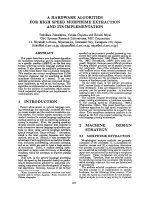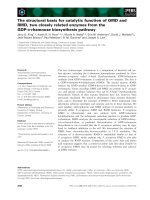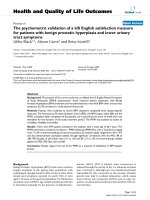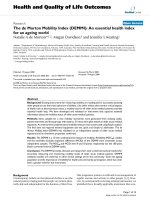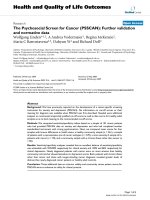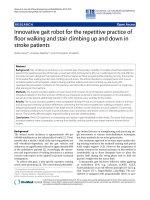báo cáo hóa học: " The Psychosocial Screen for Cancer (PSSCAN): Further validation and normative data" pptx
Bạn đang xem bản rút gọn của tài liệu. Xem và tải ngay bản đầy đủ của tài liệu tại đây (319.86 KB, 8 trang )
BioMed Central
Page 1 of 8
(page number not for citation purposes)
Health and Quality of Life Outcomes
Open Access
Research
The Psychosocial Screen for Cancer (PSSCAN): Further validation
and normative data
Wolfgang Linden*
1,2
, A Andrea Vodermaier
1
, Regina McKenzie
2
,
Maria C Barroetavena
2,3
, Dahyun Yi
4
and Richard Doll
2
Address:
1
Department of Psychology, University of British Columbia, Vancouver, B.C, Canada,
2
British Columbia Cancer Agency, Vancouver, B.C,
Canada,
3
Department of Health Care & Epidemiology, University of British Columbia, Vancouver, B.C, Canada and
4
Department of Psychology,
Fuller Theological Seminary, Pasadena, CA, USA
Email: Wolfgang Linden* - ; A Andrea Vodermaier - ;
Regina McKenzie - ; Maria C Barroetavena - ; Dahyun Yi - ;
Richard Doll -
* Corresponding author
Abstract
Background: We have previously reported on the development of a cancer-specific screening
instrument for anxiety and depression (PSSCAN). No information on cut-off scores or their
meaning for diagnosis was available when PSSCAN was first described. Needed were additional
analyses to recommend empirically justified cut-off scores as well as data norms for healthy adult
samples so as to lend meaning to the recommended cut-off scores.
Methods: We computed sensitivity/specificity indices based on a sample of 101 cancer patients
who had provided PSSCAN data on anxiety and depression and who had completed another
standardized instrument with strong psychometrics. Next, we compared mean scores for four
samples with known differences in health status, a healthy community sample (n = 561), a sample
of patients with a representative mix of cancer subtypes (n = 570), a more severely ill sample of in-
patients with cancer (n = 78), and a community sample with a chronic illness other than cancer (n
= 85).
Results: Sensitivity/specificity analyses revealed that an excellent balance of sensitivity/specificity
was achievable with 92%/98% respectively for clinical anxiety and 100% and 86% respectively for
clinical depression. Newly diagnosed patients with cancer were no more anxious than healthy
community controls but showed elevations in depression scores. Both, patients with chronic illness
other than cancer and those with longer-standing cancer diagnoses revealed greater levels of
distress than newly diagnosed cancer patients or healthy adult controls.
Conclusion: These additional data on criterion validity and community versus patient norms for
PSSCAN serve to enhance its utility for clinical practice.
Published: 24 February 2009
Health and Quality of Life Outcomes 2009, 7:16 doi:10.1186/1477-7525-7-16
Received: 23 May 2008
Accepted: 24 February 2009
This article is available from: />© 2009 Linden et al; licensee BioMed Central Ltd.
This is an Open Access article distributed under the terms of the Creative Commons Attribution License ( />),
which permits unrestricted use, distribution, and reproduction in any medium, provided the original work is properly cited.
Health and Quality of Life Outcomes 2009, 7:16 />Page 2 of 8
(page number not for citation purposes)
Background
There is steadily growing interest in routine screening for
emotional distress in cancer and other medical patients in
order to identify patients who need psychological support
most urgently [1]. Emotional distress has been recognized
as a critical 6
th
Vital Sign in medical care [2] thus mandat-
ing professional attention. Routine screening of all
patients may prevent problem worsening via early inter-
vention, assures equal access to services for all segments of
the population, and allows a fair distribution of resources
and carries potential for long-term cost savings [3,4]. Fur-
thermore, distress-reducing treatments have been effective
only when pre-treatment distress was clearly elevated
before treatment initiation [5]. Ignoring this principle
translates into a waste of valuable therapy resources that
already-strained health care systems can hardly afford.
These reasons have led to the development of screening
tools for distress.
Large-scale screening requires simple, quick tools with an
appropriate balance of brevity and still good psychomet-
rics. Particularly popular is the single item distress ther-
mometer [6] which, however has been criticized for
inadequate specificity [7,8] which then requires a referral
for additional diagnostics. This inherent weakness of a
single-item screening tool makes longer tests a preferred
choice. Given that a psychological domain of interest can
be tapped satisfactorily with only a few items [7], adding
more test items improves the psychometric quality of a
tool and permits the assessment of multiple psychological
constructs of interest.
In a review of the most frequently used tools for psycho-
social distress screening [9], it became apparent that (a)
most often measured were anxiety and depression, (b)
there was no agreement on the best screening tool, (c)
many measures were too long for routine screening, and
(d) some tools of interest were copyrighted protected and
would have to be purchased for every application.
In light of these observations, we had developed a 21-item
instrument (the Psychological Screen for Cancer, PSS-
CAN; 10) that stands out because of (a) its brevity, (b) its
development in the clinical context where it was to
become implemented, (c) the scope of the domains being
measured, (d) inclusion of both negative and positive
aspects of the patients' quality of life (namely level of dis-
tress and level of social support), and (e) its non-commer-
cial nature. Note, that after the first article on PSSCAN was
published in 2005, we were alerted that the original acro-
nym 'PSCAN' was already copyrighted. Our acronym was
then changed to carry one additional 'S' although the full
name of the test still is: "Psychosocial Screen for Cancer".
It is the objective of this paper to report additional valida-
tion results and normative data for PSSCAN. When PSS-
CAN was introduced to the literature, the tool's
development, indices of reliability, and the establishment
of concurrent and construct validity for cancer popula-
tions had already been described [10]. PSSCAN assesses
anxiety and depression, perceived social support, desired
social support, and health-related quality-of-life. It has
good psychometrics including high internal consistency
(alpha averaging .83, and acceptable test-retest stability
over 2 months (averaging r = . 64).
Since then, this tool has been implemented in four Cana-
dian cancer centers [11] and the test developers have
received further requests for permission to use PSSCAN
from Ireland, the U.S., Japan, Australia, Switzerland, Bra-
zil, Colombia, and Mexico.
Clinicians working with PSSCAN have repeatedly asked
for cut-off scores to assist with them with the decision of
whether or not a patient had a diagnosable disorder in
need of treatment. While researchers can 'bathe in the rel-
ative luxury' of statistically treating continuous variables
like anxiety as indeed continuous, clinicians are required
to make dichotomous decisions about whether or not a
given patient has a defined disorder, and will receive a
particular form of treatment or further diagnostic services.
This is important because health care systems will typi-
cally fund psychological treatment only if it is for patients
with a diagnosed disorder. No information on cut-off
scores and their meaning for diagnosis was available for
PSSCAN when it was first published. We now have con-
ducted additional analyses to recommend specific cut-off
scores and have also gathered data from healthy, norma-
tive adult samples so that both the clinical and healthy
norm data can be used to lend meaning to the cut-off
scores recommended here.
The specific aims of this paper are to describe the compu-
tation of Areas under the Curve (AUC) and resulting sen-
sitivity and specificity indices for the anxiety and
depression subscales of PSSCAN. Next it is discussed how
sensitivity/specificity information was used to establish
empirically-driven cut-off scores. Finally, mean scores and
standard deviations on anxiety and depressive symptoms
are reported for four samples, representing healthy adults,
individuals from the community who have a life-threaten-
ing or chronic illness, in-patients with cancer, and a sam-
ple of recently diagnosed out-patients with cancer. These
comparisons illustrate prevalence rates of anxiety and
depression in cancer samples and also place them within
the larger context of population norms.
Health and Quality of Life Outcomes 2009, 7:16 />Page 3 of 8
(page number not for citation purposes)
Study 1: Sensitivity- Specificity Analyses
Methods
Data collection
Sensitivity and specificity computations were conducted
on the data set used originally for concurrent validity test-
ing for PSSCAN, n = 101 [10]. Given that these patients
had completed parallel measures of other established anx-
iety and depression tools which do have empirically justi-
fied cutoffs, sensitivity and specificity for PSSCAN cutoffs
could be computed. This sample consisted of patients
making first contact with the BC Cancer Agency at the
Vancouver Center; eligible patients were recruited consec-
utively by two trained research assistants over a period of
one month. The research assistants were physically
located in the reception area, were alerted about poten-
tially eligible patients by the receptionist, and then
approached patients individually to explain the study,
seek consent, and request completion of a test package. All
sub-studies were individually approved by the local ethics
committee
Outcome measures
The questionnaire package consisted of the PSSCAN as
described above, the Hospital Anxiety and Depression
Scale (HADS; 12) and a social support instrument which,
however, was not further investigated here because level
of social support is not typically used for making clinical
diagnoses, and because no meaningful cut-offs were avail-
able for comparison. The HADS is a very frequently used
14-item scale tapping anxiety and depression. Bjelland et
al. [13] reviewed the psychometrics of the HADS based on
747 published studies and reported Cronbach's alphas of
.68 to .93 for anxiety and .67 to .90 for depression. Factor
analyses routinely confirm the underlying 2-factor struc-
ture [14-16]. The suggested cutoffs, based on comparisons
with structured interviews, to identify subclinical and clin-
ical cases respectively are 8 and above, and 11 and above, on
the anxiety and depression subscales alike [12,13].
Statistical analyses
Receiver operating characteristic (ROC) curve analyses
were performed for the anxiety and the depression sub-
scales of PSSCAN and the corresponding validated meas-
ure namely the HADS anxiety and depression subscales.
The resulting ROC curve statistics provide both a visual
description of the relationship between PSSCAN data and
the criterion indices (HADS anxiety and depression sub-
scales), and allowed the computation of the overall fit sta-
tistic, and sensitivity and specificity. A perfect screening
tool would explain 100% of the Area Under the Curve
(AUC) and would receive a corresponding statistical fit
score of 1.0. The AUC is statistically interpreted as describ-
ing sensitivity/specificity in percent such that an ideal cut-
off would approach 100% on both. Given that it is
unlikely that both numbers are exactly the same for any
given cutoff score, one needs to decide whether it is more
important to have high sensitivity and possibly lower spe-
cificity or vice versa. Either decision comes with its own
distinct costs. If the test has a very low cutoff, then it is
likely to have very high sensitivity and will identify a large
number of patients that will then require further, possibly
expensive, diagnostic assessments. Given that screening
tests are not meant to substitute full clinical diagnoses, a
decision to seek higher sensitivity than specificity is con-
sidered optimal in that the right kinds of patients are iden-
tified with the fewest resources wasted.
With regard to the ROC curve analyses for the two con-
structs that are measured by PSSCAN and the established
criterion measure, namely the HADS subscales, a criterion
of 8 or above on the HADS Anxiety Scale was taken as an
indication of a subclinical diagnosis and a criterion of 11
or above as a likely clinical diagnosis of elevated anxiety.
Likewise, a score of 8 or above on the Depression Subscale
of the HADS was taken as a criterion for a subclinical diag-
nosis and a score of 11 or above as a likely diagnosis of
clinical depression [13]. The question here was which cut-
off score on the PSSCAN corresponded with these cut-off
scores for the HADS subscales.
Results
Complete data were available from 101 cancer patients
with a mean age of 53 years, composed of 60 women and
41 men. ROC curves are displayed in Figures 1a and 1b,
and Figures 2a and 2b; sensitivity/specificity data are
shown in Table 1.
Anxiety Subscale
Figure 1a shows the receiver operating characteristic of the
PSSCAN anxiety subscale with the HADS anxiety subclin-
ical cutoff score as the criterion. PSSCAN is highly sensi-
tive and specific for screening for anxiety as indicated by
an overall Area Under the Curve (AUC) of .85 (P < .001).
In addition, Figure 1a also displays the varying sensitivity
and specificity percentages depending on which PSSCAN
score is used as the cut-point. As the data in Figure 1a indi-
cate, a cut-point of 8 or above is therefore best for identi-
fying mild (subclinical) anxiety and results in a sensitivity
of .79 and a specificity of .83.
Using the clinical cutoff of the HADS to identify anxiety
disorders resulted in an AUC of .99 (P < .001). The opti-
mal cut-off was 11 or above with a sensitivity of .92 and a
specificity of .98 (Figure 1b).
Depression Subscale
Figure 2a shows the receiver operating characteristic of the
PSSCAN depression subscale with the HADS subclinical
score as the criterion. An AUC of .88 (p < .001) indicates
that the PSSCAN depression subscale is highly sensitive
Health and Quality of Life Outcomes 2009, 7:16 />Page 4 of 8
(page number not for citation purposes)
a and bFigure 1
a and b. Receiver Operating Curves for the Anxiety Sub-
scale of the PSSCAN with the Anxiety Subscale of the HADS
as the Criterion; Fig a: subclinical threshold; Fig b clinical
threshold.
a and bFigure 2
a and b. Receiver Operating Curves for the Depression
Subscale of the PSSCAN with the Depression Subscale of the
HADS as the Criterion; Fig a subclinical threshold; Fig b clini-
cal threshold).
Health and Quality of Life Outcomes 2009, 7:16 />Page 5 of 8
(page number not for citation purposes)
and specific for screening of depression in cancer patients.
As the data in Figure 2a indicate, a cut-off point of 8 and
greater results in a sensitivity of .89 and a specificity of .76
to detect depressive symptoms.
Figure 2b shows the ROC curves of the PSSCAN depres-
sion subscale with the clinical cutoff of the HADS as the
criterion. This resulted in an AUC of .91 (P < .001). The
corresponding ideal cutoff on the PSSCAN to detect major
depressive disorders was 11 and greater with a sensitivity
of 1.00 and a specificity of .86.
Study 2: Criterion Validation and Population norms via
Comparison of Patient versus Non-patient Groups
Methods
Participants and accrual of samples
Criterion validity was tested by comparing four samples
that were known to differ in health status.
Sample 1 was the large sample (n = 570) of cancer patients
described in the original manuscript [10]. Sample 2 was a
small in-patient sample of cancer patients, and Samples 3
and 4 were community samples. Sample 2 was obtained
by collecting PSSCAN information from patients on an
inpatient ward in the local cancer center. This inpatient
ward typically serves roughly equal portions of two kinds
of patients, namely one group with fairly advanced cancer
who will likely move from the acute cancer ward to a pal-
liative care environment, and another group that requires
extensive tests and/or treatment; these latter patients
come from outlying communities and could not make
themselves available on a daily basis for treatments or
lengthy assessments during the day, and then return home
at night. A research assistant spent one month approach-
ing all patients on the ward by scanning charts for newly
arrived patients. A total of 78 participants were thus accu-
mulated for sample 2, which is characterized by an estab-
lished diagnosis of cancer and typically advanced disease
with unknown or poor prognosis. This sample had a
mean age of 56.9 years, representing 39 women and 39
men.
Samples 3 and 4: In order to access a fairly representative
sample of adults living in the community, two research
assistants approached commuters waiting for a car ferry.
This ferry has a shuttle function and crosses a local river in
five-minute intervals. Given that the ferry capacity is rou-
tinely insufficient for the amount of traffic, commuters
typically spend between 15 and 60 minutes waiting for
the ferry, sitting in their cars on a public road, with little
to do. Depending on the time of day this ferry transports
people on their way to and from work, or shoppers and
casual travelers between two communities. The research
assistants moved from car to car, introduced themselves,
revealed photo IDs identifying them as research assistants
of the local university, explained the study to participants,
and obtained written consent to participate. Over 90% of
all individuals asked to participate, did so and received a
set of two different-colored ballpoint pens with the logo
of the university as a gift in exchange for their time. In
addition to completing the PSSCAN, they also indicated
their age and gender, and responded to the question of
whether or not they had a chronic illness. Individuals
reporting a positive diagnosis of cancer were excluded
from these community samples. Chronic illness was
defined as having heart disease, arthritis, diabetes, or an
autoimmune disease, or any other disease of similar sever-
ity (participants provided this information in an open
response form). A minimum age threshold of 40 years of
age was set for participation in order to increase the prob-
ability that the resulting sample was similar in age to typ-
ical cancer populations which usually have a mean age
between 50 and 60 years. No upper age limit was set. The
resulting sample was on average 53.6 years old and con-
sisted of 358 women and 394 men. Complete data were
available for 561 participants who declared themselves to
be healthy, and another 85 participants who reported to
have a chronic illness.
This sample of convenience represents a wide range of
ages, both sexes, as well as people of varying socio- eco-
nomic strata given that there is only one ferry system in
this location for people of all income levels. This data col-
lection process provided samples 3 and 4, one healthy, the
other one with a chronic illness.
Table 1: Sensitivity/specificity criteria
Cutoff (in brackets) Sensitivity Specificity
Anxiety
Subclinical Disorder (= 8 or >) AUC = 0.85 79% 83%
Clinical Disorder (= 11 or >) AUC = 0.99 92% 98%
Depression
Subclinical Disorder (= 8 or >) AUC = 0.88 89% 76%
Clinical Disorder (= 11 or >) AUC = 0.91 100% 86%
Note. AUC = Area under the Curve
Health and Quality of Life Outcomes 2009, 7:16 />Page 6 of 8
(page number not for citation purposes)
Results
Means and standard deviations for all four samples are
displayed in Table 2 allowing the comparison of anxiety
and depression scores for four groups of people, one can-
cer outpatients, another one a group of inpatients with
more advanced cancer, one large group of healthy com-
munity members, and another comparison group of com-
munity members with a chronic disease other than cancer.
Inferential tests were conducted by first computing effect
sizes (Cohen's d) and subsequent extraction of critical
thresholds from power tables. Given that we conducted
multiple pair-wise tests (five tests per outcome variable),
we used Bonferroni corrections and set the critical p-value
at p = .01 for 99% power [17]. The between-group differ-
ences for each of the five comparisons per variable are dis-
played as effect sizes in Table 2.
As the data in Table 2 reveal, recently diagnosed out-
patients with cancer reported less anxiety than in-patients
with cancer, and less anxiety than community-living
patients with other chronic illnesses; they were no more
or less anxious than a healthy community comparison
group. The in-patients with cancer reported more anxiety
than the healthy community sample but not more than
the community-living sample with a chronic illness other
than cancer. Lastly, the healthy community sample
reported less anxiety than the ill community sample.
With respect to depressive symptoms, the results were
similar. Recently diagnosed out-patients with cancer
reported fewer depressive symptoms than cancer in-
patients, reported as many depressive symptoms as com-
munity-living patients with other chronic illnesses, and
they were more depressed than the healthy community
comparison group. The in-patients with cancer reported
more depressive symptoms than the healthy community
sample but not more than the community sample of peo-
ple with non-cancer illnesses. Lastly, the healthy commu-
nity sample reported fewer depressive symptoms than the
ill community sample.
Discussion
The first objective of this research was to identify cut-off
points that represented the best balance of sensitivity and
specificity for the anxiety and depression subscales of PSS-
CAN and these were compared against a similar, well
established measure that had been validated against gold
standard definitions of anxiety and depression. These
computations revealed that a score of eight and above on
the anxiety and the depression subscales respectively were
associated with a high sensitivity and specificity for the
detection of anxiety and depressive symptoms. A cut off
score of 11 and above for anxiety and depression scales
respectively possessed even higher sensitivity and specifi-
city of the two PSSCAN subscales in their ability to detect
clinical levels of anxiety and depression. These findings
suggest that PSSCAN, despite its brevity, offers sufficient
sensitivity and specificity to be useful not only for initial
screening but for the establishment of a working diagnosis
that justifies a referral to a mental health professional.
The second objective was to place these cut-off scores in
the context of norms for different populations. This com-
parison allowed two main conclusions. First of all, review
of the percentile scores for sample 1 (displayed in table 3)
that 16% percent of patients will be declared clinically
anxious using a PSSCAN cut-off score of 11 and above,
and 18% will be identified as likely clinically depressed by
using a depression cut-off score of 11 and above.
Secondly, comparison of the four samples with each other
revealed that the sample of recently diagnosed cancer
patients was not more anxious than the healthy commu-
nity group but patients did have higher depression scores
than healthy individuals. Recently diagnosed cancer
patients reported levels of anxiety and depression similar
to the sample of adults drawn from the community who
reported having a chronic disease other than cancer. Can-
Table 2: PSSCAN means (and SD) for anxiety and depressive symptoms in four comparison samples, and effect size d for the
differences of all paired sample comparisons
Sample 1 Cancer Out-
patients, N = 570
Sample 2 Cancer In-
patients N = 78
Sample 3 Community sample with
chronic illness N = 85
Sample 4 Healthy Community
sample N = 561
Anxiety 8.2 (4.2) 10.9 (5.1) 10.2 (4.9) 7.7 (3.3)
1 vs 2: d = 57* 2 vs 3: d = .14 3 vs 4: d = .81*
1 vs 3: d = 43* 2 vs 4: d = .76*
1 vs 4: d = .10
Depression 8.2 (5.1) 9.8 (4.6) 9.4 (4.9) 7.2 (2.7)
1 vs 2: d = 33* 2 vs 3: d = .08 3 vs 4: d = .58*
1 vs 3: d = 24* 2 vs 4: d = .70*
1 vs 4: d = .26*
* = p < .01 on t-test
Health and Quality of Life Outcomes 2009, 7:16 />Page 7 of 8
(page number not for citation purposes)
cer inpatients also tended to be more anxious and
depressed than other comparison groups. Overall, our
data suggest that the prevalence of elevated anxiety and
depressive symptoms as assessed by PSSCAN are relatively
low compared to a number of other studies that
attempted to determine population prevalence of nega-
tive mood [18,19].
In terms of clinical implications, we posit that the sug-
gested cut-off scores are empirically justified decision-
making points for everyday clinical practice. Clinicians
can use the higher or lower cut-offs for subclinical and
clinical levels of distress respectively to determine which
patients should be referred for further diagnosis and treat-
ment. It also appears that the great majority of newly diag-
nosed cancer patients do not present with anxiety and
depressive disorders and that patient counseling services
and local service providers are not likely to get over-
whelmed with a need for clinical service when distress
screening is routinely conducted (see prevalence rates in
table 3).
There are, of course, limitations to this work. In particular,
the comparison of mean scores for the different samples
should be undertaken with some caution given that we are
comparing groups of people who were recruited by differ-
ent means; and for many of them we have limited
amounts of information. For example, relying on self-
report about presence of a chronic illness is admittedly
crude although we don't doubt the veracity of self-report.
Also, comparisons of the two smaller samples are predict-
ably less trustworthy and probably more difficult to repli-
cate than the comparisons of the much larger samples. We
do not know whether participants differed in economic
status or ethnic origin. Given that to the best of our
knowledge no such recruiting method has been used pre-
viously, we can only speculate about comparability. In
both instances, respondents were free to make their own
choices; roughly 90% of eligible participants in both set-
tings participated, and we used an age cutoff as a selection
strategy in order to achieve a roughly age-matched control
sample. Furthermore, the situations were similar in that
respondents were in a waiting situation, seated with rea-
sonable comfort, and questionnaire completion might
actually have been a welcome distraction.
The reader may be tempted to ask why one should not use
the HADS instead of PSSCAN given that the sensitivity/
specificity of the tool had been compared with that of the
HADS in the first place. There are two reasons for contin-
uing work on the PSSCAN: [a] The HADS is a copyrighted
instrument that needs to be purchased whereas PSSCAN is
free and placed in an open access journal. [b] The second
major difference is that the HADS measures only two con-
structs, namely anxiety and depression. PSSCAN on the
other hand measures five psychological constructs,
namely perceived social support, desired social support,
and quality of life in addition to tapping into the anxiety
and depression. It represents a more comprehensive
measure of psychological constructs of interest for Psy-
cho-Oncology and other chronic diseases.
In summary, the additional data reported here regarding
validity and norms for PSSCAN provide additional sup-
port for the utility of PSSCAN in everyday clinical practice.
Abbreviations
AUC: Area under the Curve.
Competing interests
The authors declare that they have no competing interests.
Authors' contributions
WL contributed to design, the statistical analyses, and was
the primary manuscript author; AV contributed to the sta-
tistical analyses and was secondary author, RM contrib-
uted to design and data collection; MCB contributed to
the design, DY assisted with data collection and statistical
analysis, RD contributed to the design and writing of the
manuscript
Acknowledgements
Funding was provided by the BC Cancer Agency and the M. Smith Founda-
tion for Health Research
Table 3: Percentiles for norming (Sample 1, n = 570 cancer
patients)
Anxiety Depression Distress Suicidality
Score % Score % Score % Score %
5 31.8 5 36.1 10 22.7 Not at All 91.7
6 46.2 6 48.7 12 42.3 A Little Bit 97.0
7 58.2 7 59.6 14 55.7 Moderately So 98.1
8 68.1 8 67.3 16 65.9 Quite a Bit 98.8
9 75.5 9 71.9 18 73.4 Very Much So 100
10 81.4 10 77.4 20 78.6
11 83.8 11 81.8 22 84.8
12 86.6 12 85.6 24 87.0
13 89.6 13 88.5 26 89.2
14 91.6 14 90.8 28 92.1
15 92.9 15 93.4 30 93.9
16 94.9 16 95.5 32 95.9
17 96.2 17 97.0 34 97.4
18 97.2 18 98.0 36 98.4
19 98.5 19 98.4 38 98.9
20 99.0 20 98.6 40 99.1
21 99.4 21 98.8 46 99.6
24 100 22 99.2 48 100
25 100 23 99.5 50 100
24 99.8
25 100
Publish with BioMed Central and every
scientist can read your work free of charge
"BioMed Central will be the most significant development for
disseminating the results of biomedical research in our lifetime."
Sir Paul Nurse, Cancer Research UK
Your research papers will be:
available free of charge to the entire biomedical community
peer reviewed and published immediately upon acceptance
cited in PubMed and archived on PubMed Central
yours — you keep the copyright
Submit your manuscript here:
/>BioMedcentral
Health and Quality of Life Outcomes 2009, 7:16 />Page 8 of 8
(page number not for citation purposes)
References
1. Jacobson PB: Screening for psychological distress in cancer
patients: Challenges and Opportunities. J Clin Oncol 2007,
25:4526-4527.
2. Bultz BD, Carlson LE: Emotional Distress: The Sixth Vital Sign
in Cancer Care. J Clin Oncol 2005, 23:6440-6441.
3. Carlson LE, Bultz BD: Benefits of psychosocial oncology care:
Improved quality of life and medical care offset. Health Qual
Life Outcomes 2003, 1:8.
4. Girgis A, Boyes A: Proactive routine monitoring and interven-
tion to reduce the psychosocial impact of cancer therapy.
Clinical Psychologist 2005, 9(2):70-73.
5. Linden W, Satin J: Avoidable Pitfalls in Behavioral Medicine
Outcome Research. Annals of Behavioral Medicine 2007,
33(2):143-147.
6. Roth AJ, Kornblith AB, Batel-Copel L, Peabody E, Scher HI, Holland
JC: Rapid screening for psychologic distress in men with pros-
tate carcinoma: a pilot study. Cancer 1998, 82(10):1904-8.
7. Mitchell AJ: Pooled results from 38 analyses of the accuracy of
distress thermometer and other ultra-short methods of
detecting cancer-related mood disorders. J Clin Oncol 2007,
25(29):4670-81.
8. Vodermaier A, Linden W: The How: Comprehensive review of
measures use for distress screening in cancer care. In Paper
presented at the 10th World Congress of the International Psycho-Oncology
Society Madrid/Spain; 2008.
9. Carlson LE, Bultz BD: Cancer distress screening; needs, mod-
els, and methods. J Psychosom Res 2003, 55:402-409.
10. Linden W, Yi D, Barroetavena MC, MacKenzie R, Doll R: Develop-
ment and validation of a psychosocial screening instrument
for cancer. Health Qual Life Outcomes 2005, 3:54.
11. Vodermaier A, Linden W: Emotional Distress Screening in
Canadian Cancer Care; A survey of utilization, tool choices,
and practice patterns. Oncol Exchange 7:37-40.
12. Snaith RP: The Hospital Anxiety and Depression Scale. Health
Qual Life Outcomes 2003, 1:1-29.
13. Bjelland I, Dahl AA, Haug TT, Neckelmann D: The validity of the
Hospital Anxiety and Depression Scale. An updated litera-
ture review. J Psychosom Res 2002, 52(2):69-77.
14. Moorey S, Greer S, Watson M, Gorman C, Rowden L, Tunmore R,
Robertson B, Bliss J: The factor structure and factor stability of
the hospital anxiety and depression scale in patients with
cancer. Br J Psychiatry 1991, 158:255-9.
15. Smith AB, Selby PJ, Velikova G, Stark D, Wright EP, Gould A, Cull A:
Factor analysis of the Hospital Anxiety and Depression Scale
from a large cancer population. Psychol Psychother 2002,
75:165-76.
16. Gil F, Grassi L, Travado L, Tomamichel M, Gonzalez JR, Southern
European Psycho-Oncology Study Group: Use of distress and
depression thermometers to measure psychosocial morbid-
ity among southern European cancer patients. Support Care
Cancer 2005, 13(8):600-6.
17. Cohen J: Statistical power analysis for the behavioral sciences.
New York: Academic Press; 1977.
18. Andrade L, Caraveo-Anduaga JJ, Berglund P, Bijl RV, De Graaf R, Vol-
lebergh W, Dragomirecka E, Kohn R, Keller M, Kessler RC,
Kawakami N, Kiliç C, Offord D, Ustun TB, Wittchen HU: The epi-
demiology of major depressive episodes: results from the
International Consortium of Psychiatric Epidemiology
(ICPE) Surveys. Int J Methods Psychiatr Res 2003, 12(1):3-21.
19. Wittchen HU, Jacobi F: Size and burden of mental disorders in
Europe–a critical review and appraisal of 27 studies. Eur Neu-
ropsychopharmacol 2005, 15(4):357-76.
